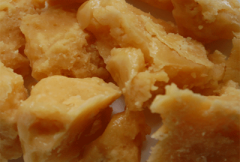Jaggery
| Infobox on Jaggery | |
|---|---|
| Example of Jaggery |  |
| Facts | |
| Origin | See text |
| Stowage factor (in m3/t) | - |
| Humidity / moisture | - |
| Ventilation | - |
| Risk factors | See text |
Jaggery
Description
Jaggery is a traditional unrefined non-centrifugal whole cane sugar consumed in Asia, Africa, Latin America, and the Caribbean. It is a concentrated product of cane juice without separation of the molasses and crystals, and can vary from golden brown to dark brown in colour. It contains up to 50% sucrose, up to 20% invert sugars, moisture content of up to 20%, and the remainder made up of other insoluble matter such as wood ash, proteins and bagasse fibers.
Jaggery is made of the products of both sugarcane and the date palm tree. The sugar made from the sap of the date palm is both more prized and less commonly available outside of the regions where it is made. The coconut palm is also tapped for producing jaggery in West Bengal, South India, Bangladesh, Pakistan, and Sri Lanka. In Sri Lanka, syrup extracts from kithul (Caryota urens) trees are widely used for jaggery production. This is considered the best quality jaggery available in local market and is given a higher value than jaggery from other sources. All types of the sugar come in blocks or pastes of solidified concentrated sugar syrup heated to 200°C. Traditionally, the syrup is made by boiling raw sugarcane juice or palm sap in large, shallow, round-bottom vessels.
Application
Jaggery is mixed with other ingredients, such as peanuts, condensed milk, coconut, and white sugar, to produce several locally marketed and consumed delicacies.
Shipment / Storage / Risk factors
It is a very moist form of sugar obtained from certain palm trees. Usually shipped in bags. Sometimes used as a source of alcohol. Liquefies when subjected to high temperatures. Very syrupy; requires efficient separation.
Subject to loss in weight, sometimes amounting 10%, or more on voyages through the tropics.
<r>











